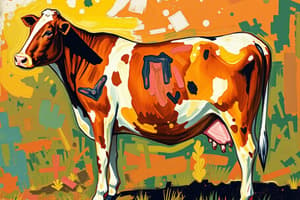Podcast
Questions and Answers
What percentage of global greenhouse gas emissions comes from the livestock sector?
What percentage of global greenhouse gas emissions comes from the livestock sector?
- 64%
- 23%
- 18% (correct)
- 30%
Animal production contributes significantly to deforestation.
Animal production contributes significantly to deforestation.
True (A)
Livestock now use ___ percent of the earth’s entire land surface.
Livestock now use ___ percent of the earth’s entire land surface.
30
What is animal husbandry?
What is animal husbandry?
Which of the following is NOT a negative impact of animal production?
Which of the following is NOT a negative impact of animal production?
Which term refers to the act of giving birth in farm animals?
Which term refers to the act of giving birth in farm animals?
Match the following terms with their definitions:
Match the following terms with their definitions:
What does the term 'dam' refer to in animal science?
What does the term 'dam' refer to in animal science?
What is the primary purpose of the livestock sector's growth?
What is the primary purpose of the livestock sector's growth?
Flashcards are hidden until you start studying
Study Notes
Introduction to Animal Science
- Livestock sector generates 18% of global greenhouse gas emissions, surpassing transport.
- Major emissions sources: manure (37% of human-induced methane) and ammonia (64% contributing to acid rain).
- Livestock occupies 30% of Earth's land surface; deforestation primarily driven by pasture expansion.
Animal Characteristics
- Animals are multicellular organisms with specialized sense organs and nervous systems, allowing rapid responses to stimuli.
- They consume organic materials and reproduce sexually while requiring oxygen for respiration.
- Major resources provided: food, fiber, leather, fuel, and draft power.
Man, Animal, and Ecosystem
- Increasing consumer demand for meat and dairy products drives production growth.
- Global meat production projected to rise from 229 million tons to 465 million tons by 2050; milk output to increase from 580 million tons to 1,043 million tons.
- The livestock sector employs around 1.3 billion people and contributes 40% to global agricultural output.
Animal Husbandry
- Also known as zoo techniques, it involves breeding, feeding, care, and management of domesticated animals for profit.
Negative Impacts of Animal Production
- Livestock production is highly polluting, contributing to land and water degradation.
- Pollution sources include animal waste, antibiotics, hormones, tannery chemicals, fertilizers, and pesticides.
Benefits of Animal Production
- Provides protection, security, recreational opportunities, and sources of power.
- Contributes to medicine, organic fertilizers, biogas/biofuel, and diverse products including musical instruments.
Terminology in Animal Science
- Dam: Refers to the female parent animal.
- Parturition: General term for the act of giving birth in farm animals.
- Calving: Specific term for giving birth in cows.
- Farrowing: Term for giving birth in sows (pig/swine).
- Foaling: Term for giving birth in mares (horses).
- Kidding: Term for giving birth in does (goats).
- Lambing: Term for giving birth in ewes (sheep).
- Draft Animals: Animals used for work purposes.
- Culling: The process of eliminating undesirable animals from a herd or flock.
Common Farm Animals
- Sheep: Ovis aries
- Goat: Capra hircus
- Cattle (Tropical): Bos indicus
- Cattle (Temperate): Bos taurus
- Horse: Equus caballus
- Swine: Sus domesticus
- Carabao: Bubalus bubalis carabenesis
- Chicken: Gallus gallus domesticus
Studying That Suits You
Use AI to generate personalized quizzes and flashcards to suit your learning preferences.




